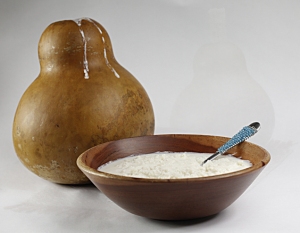 |
| Shutterstock |
From nourishment for infants to the perfect cookie accompaniment, milk is undoubtedly a huge factor in most diets (whether you consume it daily or whether you actively avoid it!).
Milk and dairy has been a staple food of many an African tribe. For centuries, from Kenya to South Africa, milk would be made into amasi (or maas in Afrikaans), by fermenting the unpasteurized product in a calabash and left for a few days.
Still widely popular today, amasi tastes similar to yoghurt or cottage cheese and can be found ready-made in most South African supermarkets.
Here are a few reasons to give amasi a try if you haven’t already:
- It can be made into a delicious meal
There’s the traditional Zulu dish Umvumbo, or this easy way to prepare chicken, but what looks absolutely scrumptious to me is this recipe for amasi scones.
 |
| Umvumbo and amasi in a calabash. Image by MzansiStyle Cuisine |
- It’s easy to digest
If you’re anything like me and you can’t digest dairy very well (regular old cow’s milk sadly disagrees with my stomach), amasi may be a good dairy source for you, since it’s full of lactic acid. This has many probiotic effects, including better vitamin absorption, and it helps balance your stomach’s acidity levels.
 |
| Image by misszeeee.wordpress.com |
- It destroys E. coli bacteria
According to Richard Mokua’s master’s thesis, the cultures in amasi, amazingly, literally kills E. coli. He’d noticed that children in his Kenyan hometown who consumed amasi had fewer digestive upsets. As someone who is rather skeptical of such claims, it’s pretty awesome to me that this has been scientifically proven.
I’ve yet to try it myself, but it’s definitely on my to-do list. Will you be celebrating #WorldMilkDay?

No comments :
Post a Comment